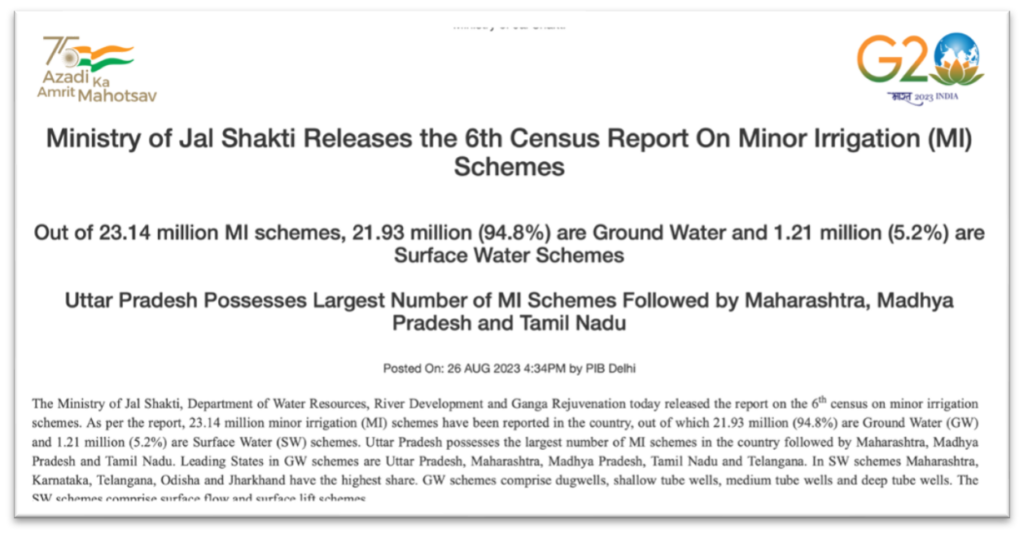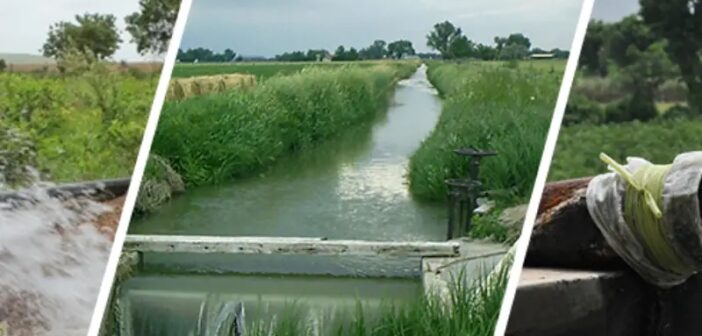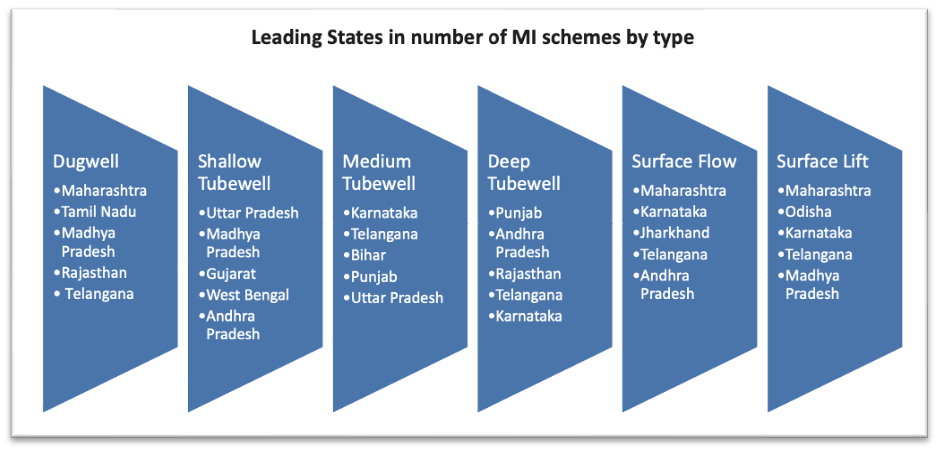Minor Irrigation Schemes (MIS) include both groundwater schemes as well as surface water schemes. As per the recently released 6th Minor Irrigation Census report, ground water schemes constitute a major part of MIS. About 94.8% of all the minor irrigation schemes in the country are groundwater schemes. Out of the total 2.31 crore MIS across the country, 2.19 crores were groundwater schemes.
Agriculture continues to be the primary activity in India. It not only provides employment to a major section of the population but also ensures food security. Over the years, the importance of Agri-products in international trade has also increased.
Agricultural production and productivity are dependent to a large extent on the availability of water. India has a high dependence on monsoons, as it recharges the groundwater levels and replenishes water bodies. However, the vagaries of the monsoons require effective water management to collect and store water for future usage when required. Irrigation projects are an effective way to manage water resources.
Since the very first Five-year plan, India has laid emphasis on irrigation. Major projects like Bhakra, Hirakud, Damodar Valley, etc. were initiated during this plan period. The emphasis continued in the later years as well. Apart from the major irrigation projects, another key component of irrigation in India is the Minor Irrigation Schemes.
A Minor irrigation scheme is a type of irrigation project that uses surface or groundwater to irrigate an area of up to 2,000 hectares. These schemes have short gestation periods and require lower investments.
6th Census of Minor Irrigation Schemes conducted for the reference year 2017-18
Minor irrigation schemes have a direct benefit to the farmer and are beneficial to the rural economy. Information relating to the minor irrigation schemes in the country helps in framing plans of action, effective utilisation of available resources, policy making, and for research.
A census on minor irrigation schemes generates such information. Recently, the Ministry of Jal Shakti released the 6th Census report on Minor Irrigation Schemes.

The first survey was conducted for 1986-87. Another four surveys were conducted for the years 1993-94, 2000-01, 2006-07 and 2013-14. The latest report is for the reference year 2017-18. The release of the same was delayed since the census work was impacted by the COVID-19 pandemic. The information for this census report is gathered from various sources.
The first census of water bodies was also conducted in convergence with the 6th minor irrigation schemes census. Factly’s series of articles on the Census of Water bodies can be read here, here, here & here.
Ground Water accounts for nearly 95% of the Minor Irrigation Schemes in the 6th Census
As indicated above in the definition, Minor Irrigation Schemes (MIS) include both Ground water schemes as well as Surface water schemes. The Ground water schemes include – dug wells, dug-cum-bore wells, shallow, medium, and deep tube wells. Surface flow schemes and Surface lift schemes are categorised as Surface schemes.
As was the case with the earlier census, groundwater schemes constitute a major part of MIS. As per the 6th Census report, 94.8% of all the minor irrigation schemes in the country are groundwater schemes. Out of the total 2.31 crore MIS across the country, 2.19 crores were groundwater schemes.
The total number of MIS in the 6th census increased by nearly 6.56% compared to that of the 5th census. This increase is mainly aided by the increase in the number of medium and deep tube wells. Medium tube wells increased by nearly 36%, while deep tube wells increased by 43%. Meanwhile, the number of Dug wells has decreased by nearly 6%, as is the case with even shallow tube wells. In the case of Surface Water MIS, there is an increase in the number of Surface Flow schemes.
97% of the schemes are in use
During the 6th MI census, the total number of schemes that are in use has increased marginally compared to the 5th MI census. Overall, there is a fall in the number of schemes not in use during the 6th Census compared to that of the 5th Census. During the 5th Census, 5.6 lakh MIS were temporarily not in use, while it fell to 4.85 lakhs in the latest census. Around 2.85 lakh MIS were permanently not in use during the 5th Census, which fell to 2.15 lakhs during the 6th Census.
Compared to surface water schemes, a higher proportion of groundwater schemes are in use.
Among the groundwater schemes, 98.5% of the shallow tube wells are in use, while in the case of medium tube wells, 98.4 % of them are in use. Comparatively, 95.7% of Deep Tube wells are in use. While 3.4% are temporarily in use, around 0.9% i.e., nearly 32.8 thousand deep tube wells are not in use.
Among the groundwater MIS, 65.3% of those that are temporarily not in use are because of ‘Less Discharge of Water’. Meanwhile, drying up is the major reason (54.1%) for the groundwater MIS to be permanently not in use. Around 6% of the Surface flow schemes are Temporarily not in use, while another 2% are permanently not in use. ‘Less Discharge of Water’ followed by ‘channel break down’ are the major reasons for Surface water MIS not being temporarily in use. Meanwhile, ‘dried up’ accounts for 30% of the Surface water MIS not being permanently used, followed by “destroyed beyond repair”.
UP, Maharashtra, MP & Tamil Nadu account for more than half of Minor Irrigation Schemes
Uttar Pradesh has the largest number of minor irrigation Schemes in India. As per the 6th census, around 17% of the schemes i.e., 39.7 lakh MIS are in the state. Maharashtra accounts for around 15% of the schemes with 35.7 lakh MIS. Madhya Pradesh, Tamil Nadu & Telangana complete the top-5 with 22.8, 21.1, and 16.7 lakh MIS respectively. These top 5 states account for around 59% of the total MIS in India. These five states also have the highest share of groundwater minor irrigation schemes in the same order as overall MIS.
However, in the case of Surface water schemes, Maharashtra has the highest number followed by Karnataka, Telangana, Odisha, and Jharkhand.
10 States out of 32 States/UTs, have more than 10 lakh MI schemes each. Seven States have MI schemes ranging between 1 lakh to 10 lakh each. The remaining 15 States/UTs have less than 1 lakh schemes each.
As highlighted above, groundwater schemes have a proportionally larger share compared to surface water schemes. This trend is true for most of the states except Northeast States. Across most of the North-east states, the proportion of surface water schemes is higher. The geography of the region has a bearing on this.
Census highlights underutilisation among the in-use schemes
The Census report highlights that under-utilisation of the ‘in-use’ MIS is the gap between irrigation potential created and irrigation potential utilised.
Out of the 2.24 crore MIS that are in use, around 14% of the schemes are highlighted to be having constraints in utilization due to reasons like – mechanical breakdown, less discharge of water, storage not fully filled up, non-availability of adequate power supply, etc. Among the groundwater MIS, Mechanical breakdown and less discharge of water are the major reasons for underutilization of the in-use MIS. Mechanical Breakdown is also the main reason in the case of Surface Water MIS that are in use and being under-utilised.






